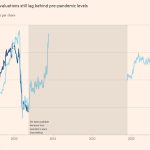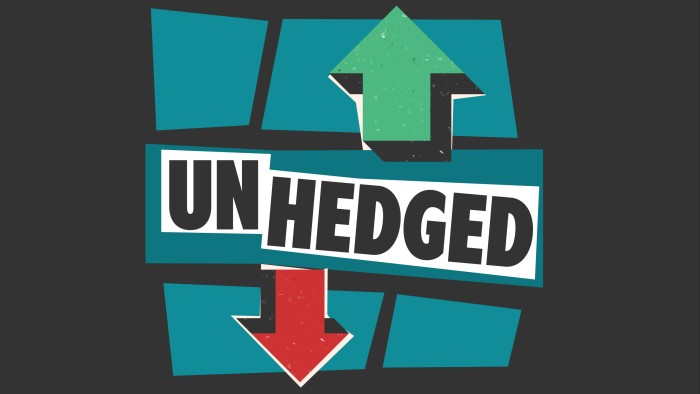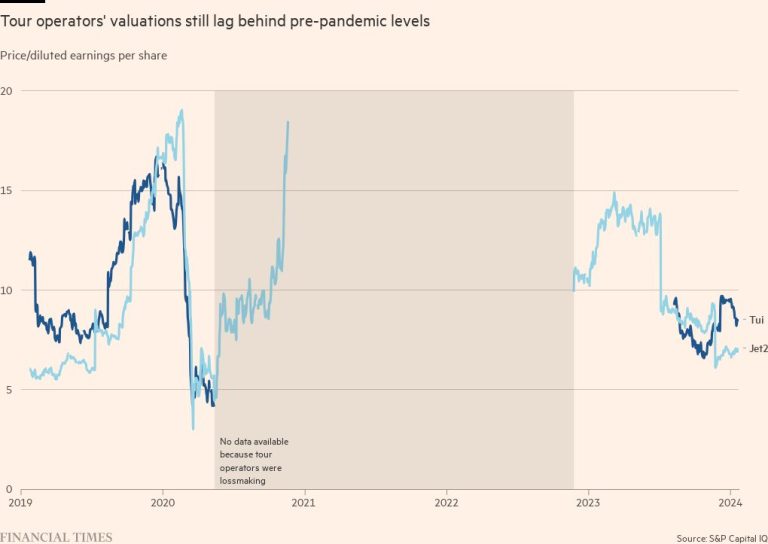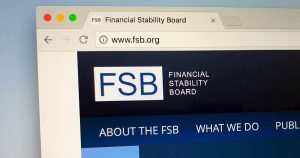This article is an on-site version of our Unhedged newsletter. Sign up here to get the newsletter sent straight to your inbox every weekday
Good morning. Ethan here; Armstrong returns next week. The year of the 100 per cent chance recession ended up being the year the US economy grew 3.1 per cent. This profession is nothing if not humbling. Email me your wisdom born of experience: ethan.wu@ft.com.
Friday interview: Rob Arnott
Rob Arnott, whose quant-focused shop Research Affiliates runs $130bn, is perhaps best known as the doyen of “smart beta”, low-cost strategies that try to beat the market a little bit. Below, he speaks with Unhedged about active investing, value’s tough run relative to growth, market efficiency and why he thinks Nvidia’s lofty valuation represents a “big market delusion”. The interview has been edited for clarity and brevity.
Unhedged: Are markets more efficient today than when you started in the business?
Rob Arnott: I don’t think so. In fact, I think the irrational swings in price have gotten slowly but surely bigger. Now that means that the opportunities to do well and to add value are larger, but take longer to play out.
We wrote a paper in 2021 called “Big Market Delusion: Electric Vehicles”. Basically, a big market delusion is when something important is happening with just a handful of companies that are pioneers in the field. So a narrative emerges: “This industry is going to be huge. It’s going to change the world. The companies in it are dominant players. They’re going to remain dominant players. So you can’t value them based on conventional valuation metrics, because this is going to be big.”
Narratives have the advantage of being largely true and the disadvantage of being entirely reflected in current share prices. So betting on a narrative is a useless way to invest. One error made in big market delusions is assuming the dominant players today will still be the dominant players 10 years from now. But often, new disrupters come along and disrupt the old disrupters. Another error is valuations getting out of hand, based on speculation that the market will grow big faster than it actually does.
The dotcom bubble is a beautiful example. You had an array of companies priced at 100-plus times earnings. Those companies were the dominant players, and some still are. But it was already in the price. So in order to do well with those investments, those companies had to do better than the narrative suggested.
Take Qualcomm. Back in 1999, it had risen more than any stock in the world. It was up over 27-fold. It makes Nvidia look like a value stock by comparison! Since then, it has remained a dominant player in the plumbing of the internet. How’s it done as a stock? You would have been twice as wealthy today investing in the S&P 500 as investing in Qualcomm back at the start of 2000. Furthermore, you had to wait 18 years to be consistently in the black, to have any [capital gain] at all. How’s Qualcomm done as a business? Profits have risen 60-fold! So the narrative was correct. But the market bet that narrative would play out a lot faster than it ultimately did.
I think the same thing is happening now with AI. The narrative with dotcom is this is going to change everything — how we buy goods and services, communicate, research, socially interact, run businesses. All true, but all have happened more gradually than initially expected. Substitute AI for internet, and you have exactly the same narrative today. It’s a classic example of a big market delusion. Not because it’s wrong, but because it will happen more gradually than people expect.
Unhedged: One difference, as you alluded to, is that Nvidia is posting strong earnings growth right now, making its multiple less extreme than Qualcomm at the peak of the dotcom bubble. Given that distinction, what makes you look at AI as a market delusion?
Arnott: I don’t doubt that Nvidia is going to be massively successful in the decade ahead. But the narrative with Nvidia is that they have a moat to produce the fast chips that are needed in AI, that it’s expensive to design and build new, even faster chips. Well, AMD announced in December that they were coming out with a chip 50 per cent faster than Nvidia’s. So competition is already happening in an area with a supposed moat.
There was a leaked internal email to top management at Google. It said we have no moat, nor does Microsoft, nor does anyone else in this business. I think the purpose of that email was Google, which was perceived as a laggard in AI, wanting to remind the marketplace that being in the lead in mile one of a marathon doesn’t mean much.
Unhedged: If markets are less efficient today, why have the classic active managers, the Franklin Templetons of the world, had such a bad time of it?
Arnott: If you’re an active manager, to win, you have to have a loser on the other side of your trade. Bill Sharpe wrote a brilliant paper 30 years ago called “The Arithmetic of Active Management”. It simply said: if you’re an index fund, you own the market. That means if you take the index funds out of the picture, you’re left with the same portfolio, the market. If you’re an active manager, you’re divvying up what’s left, which is the market. Collectively they can’t win. In fact, net of fees and trading costs, they collectively will lose. If 90 per cent of the market was indexed, the remaining 10 per cent would still be setting prices — in some cases wrongly, creating inefficiencies and opportunities.
So why have active managers had trouble keeping up? It’s very simple. Indexing is huge, but also it’s been growing. We’re working on a paper that, borrowing from American Express, we’re thinking of titling “membership has its privileges”. Stocks that are members of the S&P 500 and of the Russell 2000 index, for instance, are priced at a 30-50 per cent premium relative to similar companies that aren’t.
Now, what drove that wedge? The flow of trillions of dollars into indexing. And that means that if you have a presence in stocks outside the indices, you’ve been held back in the past by the flow of money into indices driving that wedge in valuation wider and wider. The simple quest for fair value is pushing this gap down, while the flow of money into indices pushes it wider. At some point, the inflows become slow enough to reach an equilibrium, but I don’t know if we’re there yet.
Unhedged: Can you still make money as a value investor?
Arnott: There was a head fake in 2022, when value beat growth by an enormous margin, then gave it all back in 2023. In terms of relative performance, we’re bottom-bouncing at levels not too far, above where we were in the summer of 2020.
I wrote a paper in early 2021 entitled “Reports of Value’s Death May Be Greatly Exaggerated”. Over the last 60 years, value has beat growth. Over the last 16 years, not so much. We set about to validate the notion that value investing is dead, by asking where did value’s underperformance come from? And we found, to our surprise, that over 100 per cent of the underperformance was strictly a function of value getting cheaper versus growth, relative to the underlying fundamentals. So value had a yield that for 16-17 years averaged 1.5 per cent more than growth. That should have been a 20-25 per cent improvement in performance if the underlying fundamentals performed the same. The underlying fundamentals did perform almost the same, shockingly. Ninety-nine per cent of your readers likely don’t realise that the underlying fundamentals — earnings, sales and dividends — of value stocks have grown pari passu with growth stocks over the last 17 years.
Which means that the difference has come entirely due to relative cheapness, the spread in PE ratio widening from unusually narrow in 2007 to unprecedented valuation gaps in the summer of 2020. Value rebounded through spring 2021, went back to test the lows by the end of that year. Rebounded hugely in 2022, went back to test the lows. Right now, we’re sitting with relative valuation for value versus growth, measured relative to the underlying fundamentals, in the bottom 3-4 percentile of all of history. We’ve been cheaper than today, only in 2020 and at the peak of the dotcom bubble.
Unhedged: So what explains value’s historically cheap relative valuation? Is it a low rates story? Pure investor sentiment?
Arnott: Firstly, low interest rates help growth stocks a lot. If your rewards are expected to be from enormous profits 20 years from now, the net present value of those is a lot larger if interest rates are low. Inflation expectations enter the picture too. There’s no such thing as steady, stable, high inflation. If you have elevated inflation, you have elevated volatility, elevated uncertainty. Asset classes are likely to be more volatile. Geopolitics is likely to be more volatile. Inflation creates turbulence all over.
Now, why does that matter? It matters on two levels. Firstly, high inflation does push up the discount rate, which reduces the value of growth. Secondly, and much more importantly, the heightened uncertainty increases an investor’s focus on a margin of safety. That’s likely to increase the appetite for things like current earnings, tangible business growth, management planning ahead. And that tends to push people in the direction of value, because you have that underpinning of dividends and profits and stability. So inflation is the enemy of growth. High interest rates are the enemy of growth.
We’ve taken baby steps in that direction. Inflation expectations, measured by the 10-year break-even, did rise above 3 per cent in April 2022. But the shocker is that inflation expectations were lower at the end of 2022 than a year earlier and lower at the end of 2023 than a year earlier. They’re about 2.3 per cent now and, gosh, that’s the Fed’s target. Never mind Houthi attacks on container ships and the possibility of a broader war in the Middle East or Chinese acquisitiveness with regard to Taiwan. The market is suggesting none of these things matter; inflation’s going to be at the Fed’s target.
I view that as a beautiful example of a narrative where the asymmetry is self-evidently on the high side. Inflation is more likely to be 2 per cent higher than that expectation than 2 per cent lower.
Unhedged: Why do “quant winters” happen? That is, synchronised downturns in quantitative strategies’ returns, such as in 2007 and 2018-20.
Arnott: Quants like to think that they are using objective measures and are not falling prey to the emotions that lead people astray. And that’s not quite true. Take multifactor investing. How do you decide what factors to use? Typically, the answer is backtests, what’s worked best in the past. We introduced an idea in 2016 called “revaluation alpha”. If value underperforms growth entirely because value has gotten cheaper relative to its underlying fundamentals than growth has, that’s a revaluation alpha.
If you take the relative performance value versus growth and subtract the portion that’s due to revaluation, you can think of the rest of that as a crude measure of structural alpha. That’s been positive for the last 17 years. In other words, if value was priced relative to growth the same now as it was in 2007, value would have won by 1-2 per cent per year.
The point is: if you are using past returns to choose your factors, you’re going to migrate towards the factors with the best past performance, which may be the factors that have gotten more expensive.
I wrote a paper in 2016 called “How Can ‘Smart Beta’ Go Horribly Wrong?” Hugely controversial. But all it said was think of it like buying a stock. If a stock has soared and its underlying fundamentals haven’t, you can’t count on that rise to continue. Furthermore, if there’s any mean reversion, watch out. You could get badly hurt. We said exactly the same thing about factors. If we said that about stocks, people would have read it and thought, “This guy’s an idiot. Everybody knows that.” But writing it about factors, the reaction was, “How dare he?”
When I wrote that paper, most of the factors were very expensive. Today, most factors are very cheap. In a different paper I wrote a year ago, I pointed out that performance is correlated with relative valuation. That is to say, if a factor was expensive relative to its historic norms, subsequently it underperformed. If it was cheap, subsequently it outperformed. Today, people are yanking money out of quant strategies and multifactor at a pace of billions per month, but this is the time to be putting money into them! 2016 was the time to be taking money out.
Unhedged: I’m glad you brought up the “horribly wrong” paper. Cliff Asness of AQR was the chief critic of that paper. As I understand, his big counterpoint was that you’re making the case for timing the market. Sure, it looks expensive, but how can you be so sure?
Arnott: I found the controversy kind of funny because I think Cliff and I agree on most things. You can always knock down a straw man by saying well, this guy’s saying actively time factors and that’s dangerous. I wasn’t saying that. I was saying be cautious. Timing factors on every twitch is crazy, but when things get to extremes of relative valuation — cheapest decline ever, most expensive decile ever — that’s a time to be a little wary.
Quality is priced a little rich relative to history, and money is pouring into quality strategies. Of course I’d be fading those bets. When value gets this cheap, I’d be averaging in. I would not say, “This is the buying opportunity!” because nobody knows where it is. Contrarian investing is inherently a painful process. If you buy what’s newly cheap, you’re probably going to make more money by doing that. But you’re highly unlikely to get the bottom tick. So you’re going to look and feel like an idiot until the turn happens.
In January 2016, emerging markets were in freefall and had become extraordinarily cheap. And I described emerging markets’ value as the buy of a decade. What happened subsequently? Our fundamental index for emerging markets rose over 80 per cent in the year and a half after the January 2016 lows. Now, did I pick the bottom? Not exactly. I was saying almost the same thing the year before. I wasn’t saying trade of a decade; I was saying this is getting really cheap and it’s time to be averaging in. When I later said trade of a decade, it was the bottom. But that was just luck.
One good read
The deluge of fakery.
FT Unhedged podcast
Can’t get enough of Unhedged? Listen to our new podcast, hosted by Ethan Wu and Katie Martin, for a 15-minute dive into the latest markets news and financial headlines, twice a week. Catch up on past editions of the newsletter here.












+ There are no comments
Add yours